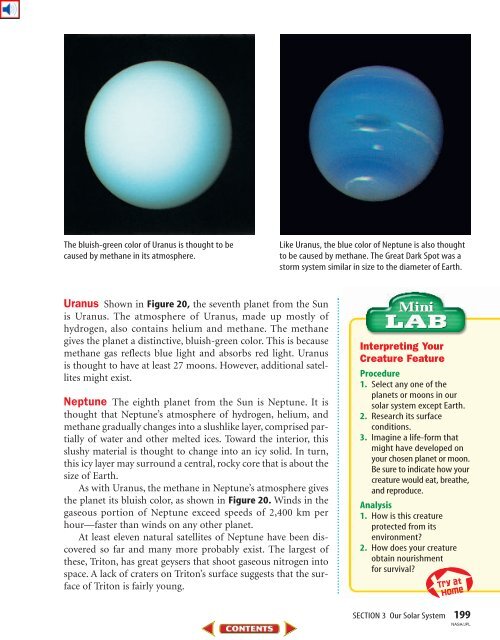Chapter 7: Earth in Space
Chapter 7: Earth in Space
Chapter 7: Earth in Space
Create successful ePaper yourself
Turn your PDF publications into a flip-book with our unique Google optimized e-Paper software.
The bluish-green color of Uranus is thought to be<br />
caused by methane <strong>in</strong> its atmosphere.<br />
Uranus Shown <strong>in</strong> Figure 20, the seventh planet from the Sun<br />
is Uranus. The atmosphere of Uranus, made up mostly of<br />
hydrogen, also conta<strong>in</strong>s helium and methane. The methane<br />
gives the planet a dist<strong>in</strong>ctive, bluish-green color. This is because<br />
methane gas reflects blue light and absorbs red light. Uranus<br />
is thought to have at least 27 moons. However, additional satellites<br />
might exist.<br />
Neptune The eighth planet from the Sun is Neptune. It is<br />
thought that Neptune’s atmosphere of hydrogen, helium, and<br />
methane gradually changes <strong>in</strong>to a slushlike layer, comprised partially<br />
of water and other melted ices. Toward the <strong>in</strong>terior, this<br />
slushy material is thought to change <strong>in</strong>to an icy solid. In turn,<br />
this icy layer may surround a central, rocky core that is about the<br />
size of <strong>Earth</strong>.<br />
As with Uranus, the methane <strong>in</strong> Neptune’s atmosphere gives<br />
the planet its bluish color, as shown <strong>in</strong> Figure 20. W<strong>in</strong>ds <strong>in</strong> the<br />
gaseous portion of Neptune exceed speeds of 2,400 km per<br />
hour—faster than w<strong>in</strong>ds on any other planet.<br />
At least eleven natural satellites of Neptune have been discovered<br />
so far and many more probably exist. The largest of<br />
these, Triton, has great geysers that shoot gaseous nitrogen <strong>in</strong>to<br />
space. A lack of craters on Triton’s surface suggests that the surface<br />
of Triton is fairly young.<br />
Like Uranus, the blue color of Neptune is also thought<br />
to be caused by methane. The Great Dark Spot was a<br />
storm system similar <strong>in</strong> size to the diameter of <strong>Earth</strong>.<br />
Interpret<strong>in</strong>g Your<br />
Creature Feature<br />
Procedure<br />
1. Select any one of the<br />
planets or moons <strong>in</strong> our<br />
solar system except <strong>Earth</strong>.<br />
2. Research its surface<br />
conditions.<br />
3. Imag<strong>in</strong>e a life-form that<br />
might have developed on<br />
your chosen planet or moon.<br />
Be sure to <strong>in</strong>dicate how your<br />
creature would eat, breathe,<br />
and reproduce.<br />
Analysis<br />
1. How is this creature<br />
protected from its<br />
environment?<br />
2. How does your creature<br />
obta<strong>in</strong> nourishment<br />
for survival?<br />
SECTION 3 Our Solar System 199<br />
NASA/JPL

















